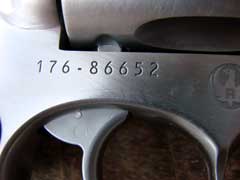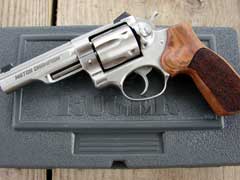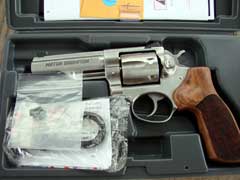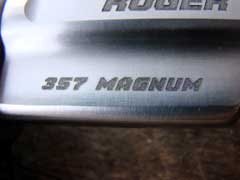|
Click pictures for a larger version.








Transfer bar safety.




Windage-adjustable rear Novak sight with interchangeable fiber-optic front
sight.

Front of cylinder is radiused.







|
|
The GP-100 double-action 357 Magnum revolver
has been in production for twenty-eight years now. I remember
back when it was first introduced, Ruger announced that they
were replacing the Security-Six with this stronger GP-100
design. I was disappointed, as the Security-Six was an excellent
sixgun. It was stronger than the S&W K-frame, which as about
the same size, very accurate, and as durable as an anvil. The
GP-100 had a hard act to follow, and compared to most of the
GP-100 line of revolvers, I still prefer the old Security-Six.
The reason for this is that the GP-100, in its
most-common form, is heavier than the Security-Six, with most GP
revolvers encountered wearing a full-lug barrel. The Six series
guns had just enough underlug to enclose the ejector rod, and it
quit right there.
However, with this new Match Champion GP-100,
Ruger got it right. Just right. The barrel wears a half-lug;
just enough to enclose the ejector rod. Also, the sides of the
barrel are machined flat, further reducing the weight of the
barrel on this GP-100. The front of the cylinder is radiused,
making the revolver just a bit easier to slide into a holster.
The Match Champion has the best trigger pull that I have ever
felt on a GP-100 sixgun. The double-action pull is
butter-smooth, and the single-action pull is very crisp. The
grip is a Hogue unit made from some type of hardwood, and the
stippling provides a secure grip, without being abrasive to the
hand. This is one of the most comfortable-to-fire 357 Magnum
revolvers that I have ever held in my hands.
The
detailed specifications of the Match Champion are listed in the
chart below. All linear measurements are in inches, and the
weight is listed in ounces. The trigger pulls are listed in
pounds of resistance. SA is the single-action trigger pull. DA
is the double-action trigger pull. Height includes the sights.
Two barrel/cylinder gap measurements are listed, as I had two
revolvers here, with differing barrel/cylinder gap measurements,
but both were very uniform from chamber to chamber.
| Weight |
37.6 ounces |
| Barrel Length |
4.2 inches |
| Trigger Pull SA |
3.75 pounds |
| Trigger Pull DA |
6.6 pounds |
| Cylinder Length |
1.61 inches |
| Cylinder Diameter |
1.55 inches |
| Chambers |
6 |
| Overall Length |
9.51 inches |
| Overall Height |
5.9 inches |
| Barrel / Cylinder Gap |
0.003 / 0.005 inch |
| Ammunition |
357 Magnum / 38 Special |
| MSRP (as of January 9, 2014) |
$899 US |
For accuracy and function testing, I tried
every type of 357 Magnum factory ammunition that I had available
to me, as well as two 38 Special hollowpoint loads. The ammo
consisted mostly of high performance ammunition, along with one
of my favorite cast bullet handloads that I use as a general
purpose plinking and casual target load. This moderate handload
uses the excellent Mt. Baldy 173
grain plain base Keith semi-wadcutter bullet (my supply is
getting low) with six grains of Hodgdon Titegroup powder. The
accuracy of the GP-100 was tested with the revolver secured into
my Ransom Master Series machine rest.
The chronograph results are listed in the chart below. The
excellent accuracy is shown in the pictures. JHP is a jacketed
hollowpoint bullet. SP is a jacketed soft point bullet. DPX and
TAC-XP loads use an homogenous copper hollow nose bullet made by
Barnes Bullet Company, as loaded by Cor-Bon and Buffalo Bore.
Glaser is a specialty jacketed bullet with a compressed
pre-fragmented core. HC is a hard-cast lead bullet. Keith is the
aforementioned semi-wadcutter cast lead bullet. Velocities were
recorded at a distance of twelve feet from the muzzle, and are
listed in feet-per-second (fps). Bullet weights are listed in
grains. Testing was done on a windy day with a steady twenty
mile per hour breeze and an air temperature in the twenty-eight
degree Fahrenheit range, at an elevation of approximately 541
feet above sea level, and relative humidity of thirty-seven
percent.
357 Magnum
| Ammunition |
Bullet Weight |
Velocity |
| Remington Golden JHP |
125 |
1237 |
| Atomic JHP |
158 |
1337 |
| Cor-Bon HC |
200 |
1133 |
| Cor-Bon DPX |
125 |
1504 |
| Cor-Bon SP |
180 |
1220 |
| Cor-Bon JHP |
125 |
1401 |
| Cor-Bon Glaser |
80 |
1736 |
| Buffalo Bore TAC-XP |
140 |
1626 |
| Buffalo Bore JHP |
125 |
1602 |
| Buffalo Bore JHP |
170 |
1247 |
| Buffalo Bore JHP |
158 |
1393 |
| Buffalo Bore HC |
180 |
1341 |
| Grizzly Cartridge HC |
180 |
1184 |
| Handload Keith |
173 |
1219 |
38 Special
| Ammunition |
Bullet Weight |
Velocity |
| Buffalo Bore +P TAC-HP |
110 |
1063 |
| Remington Home Defense +P JHP |
125 |
909 |
Accuracy varied from really good to superb
with the GP-100 Match Champion revolver. As mentioned above, all
accuracy testing was done at a distance of twenty-five yards,
with the revolver secured into my Ransom Master Series machine
rest. With each type of ammunition tested, the Ruger exhibited
good accuracy. The largest group fired of the day measured just
under two and one-half inches. The most-accurate ammo would
consistently group five shots into one and one-quarter inches or
less.
The Hogue hardwood grip on the Match Champion
revolver handles the recoil of the 357 Magnum cartridge very
well. The grip shape and angle feel as if it was made to fit an
actual human hand, and the weapon points naturally for me. The
front sight is easy to see in most lighting conditions. If there
is any available light at all, the fiber-optic rod picks it up
well, making the front sight easy to get on target. For
paper-punching, the square profile of the front sight aids
accurate shooting. The rear Novak sight is smooth, rugged, and
adjustable for windage correction, if needed.
Extraction and ejection was smooth and easy
with every load tested; even the hottest Buffalo Bore and
Cor-Bon stuff. Most cases fell from the chambers without the aid
of the extractor. The GP design locks the cylinder into place at
three points; the rear of the cylinder at the center of the
extractor star, the front of the cylinder at the crane, and at
the bottom of the cylinder at the bolt notches. This system
offers an aid to both strength and accuracy. The smooth trigger
pull also contributed to the sixgun’s practical
accuracy, making the weapon easy to keep on target as the
trigger is pressed.
A lot of shooters these days dismiss the
revolver in favor of a higher-capacity semi-automatic. There is
nothing wrong with choosing a semi-auto for a hunting or
fighting handgun, but a good 357 Magnum revolver usually offers
better accuracy, and more power, using the best ammunition
available. Also, a revolver does not leave brass scattered on
the ground, which may or may not be a problem for the shooter,
depending upon whether or not it is legal to carry and use a
firearm in that particular location. I always recommend that
people obey the law, but when the law violates your right to
keep and bear arms, I no longer recommend obeying that law. It
is often necessary to carry a gun where doing so violates the
law. If forced to use a firearm in such a situation, leaving
behind brass is a bad idea, and a revolver does not leave brass
on the ground. For whitetail deer hunting, a 357 Magnum sixgun
like this GP-100 is an excellent choice, having the accuracy and
power needed to cleanly harvest the animal at short to moderate
distances.
With the creation of this new GP-100 Match
Champion, Ruger has built my favorite 357 Magnum double-action
revolver. It is smooth, accurate, reliable, tough, and sized
just right. They paid attention to the details, and got the
details right. Like all Ruger firearms, the GP-100 is built
right, and built in the USA.
Check out the extensive line of Ruger
firearms and accessories online at www.ruger.com.
For the location of a Ruger dealer near you,
click on the DEALER FINDER at www.lipseys.com.
To order the GP-100 online, click on the Gun
Genie at www.galleryofguns.com.
To order premium quality 357 Magnum and 38
Special ammunition online, go to www.buffalobore.com,
www.luckygunner.com,
www.doubletapammo.com,
and www.midsouthshooterssupply.com.
Jeff Quinn
NOTE: All load data posted on this
web site are for educational purposes only. Neither the author nor
GunBlast.com assume any responsibility for the use or misuse of this data.
The data indicated were arrived at using specialized equipment under
conditions not necessarily comparable to those encountered by the
potential user of this data. Always use data from respected loading
manuals and begin working up loads at least 10% below the loads indicated
in the source manual.
  
Got something to say about this article?
Want to agree (or disagree) with it? Click the following link to
go to the GUNBlast Feedback Page.
|
|
Click pictures for a larger version.










One of Jeff's favorite 357 Magnum loads is this 140-grain lead-free from
Buffalo Bore.







Superb accuracy.



|
![]()